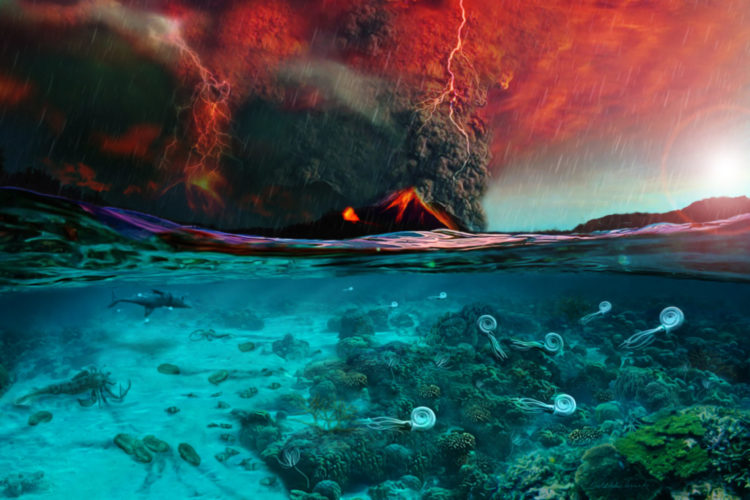Great Dying – what caused Earth’s biggest mass extinction?

New research led by the University of St Andrews and renowned German research centres helps answer one of the most asked questions in geoscience: what exactly caused the Earth’s biggest mass extinction?
Approximately 252 million years ago, long before the emergence of dinosaurs, at the Permian-Triassic boundary, the largest of the known mass extinctions on Earth occurred. With more than 95% of marine species becoming extinct, life in Permian seas, once a thriving and diverse ecosystem, was wiped out within only tens of thousands of years, a geological blink of an eye. This is now referred to as the ‘Great Dying’, a period when life on Earth has never been so close to becoming extinct.
Scientists have long debated the theories of the cause of the extinction ranging from bolide impact and dissolution of gas hydrates to volcanoes, which could have caused climatic and environmental changes making Earth so inhospitable to life.
Now new research, led by an international team of scientists from the GEOMAR Helmholtz Centre for Ocean Research Kiel in cooperation with the Helmholtz Centre Potsdam GFZ German Research Centre for Geosciences and the School of Earth and Environmental Sciences at the University of St Andrews, including Italian and Canadian universities and published in Nature Geoscience (Monday 19 October) provides, for the first time, a conclusive picture of the underlying mechanism and consequences of the extinction and finally answers the key questions – what exactly caused Earth’s biggest mass extinction and how could an event of such a deadly magnitude unfold?
The team of researchers, led by Dr Hana Jurikova, now based at the University of St Andrews, used a novel analytical approach of different isotopes of the elements boron and carbon, retrieving the pH of the ancient ocean from fossil brachiopod shells. Although numerous brachiopod species also became extinct during the Great Dying, the team found brachiopod shells within the critical time interval which offered a snapshot of the rapid onset of the extinction. Seawater pH is a critical indicator that not only records ocean acidity, which varies depending on the amount of absorbed carbon dioxide (CO2), but together with carbon isotope constraints it also allowed the team to determine changes in the amount and sources of atmospheric CO2 at the time of the extinction event.
The team were able to determine that the trigger of the Permian-Triassic crisis was a large pulse of CO2 to the atmosphere originating from a massive flood basalt province, the result of a giant volcanic eruption in today’s Siberia. Analyses showed that the volcanisms released more than 100,000 billion tonnes of carbon into the atmosphere, triggering the onset of the extinction. This is more than 40 times the amount of all carbon available in modern fossil fuel reserves including carbon already burned since the industrial revolution.

The research team used innovative modelling to reconstruct the effect of such large CO2 release on global biogeochemical cycles and the marine environment. The findings showed that, initially, the CO2 perturbation led to extreme warming and acidification of the ocean that was lethal to many organisms, especially those building calcium carbonate shells and skeletons. The greenhouse effect, however, led to further dramatic changes in chemical weathering rates on land and nutrient input and cycling in the ocean that resulted in vast deoxygenation and probably also sulphide poisoning of the oceans, killing the remaining organism groups.
The Permian-Triassic mass extinction was therefore a cascading collapse of vital global cycles sustaining the environment driven by an immense multi-millennial carbon injection to the atmosphere. The extreme changes and multiple stressors – high temperatures, acidification, oxygen loss, sulphide poisoning – combined to wipe out a large variety of marine organisms, explaining the severity of the extinction.
Lead researcher Dr Jurikova said: “Our research provides the first precise reconstruction of the carbon source and with it the trigger of the crisis, as well as uncovers the subsequent chain of processes that resulted in Earth’s largest mass extinction.
“It took several hundreds of thousands to millions of years for the ecosystem to recover from the catastrophe, which profoundly altered the course of evolution of life on Earth.”
Category Research